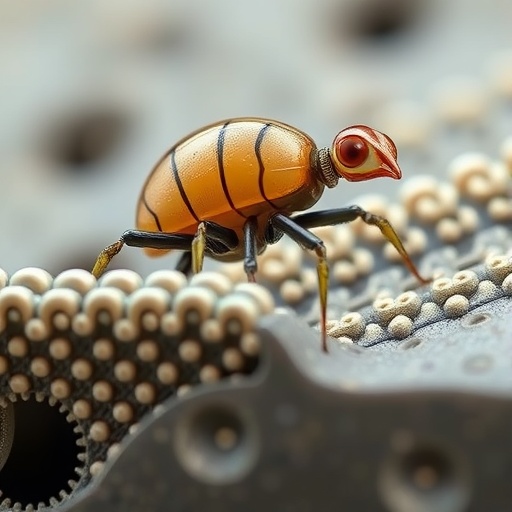In a groundbreaking advance at the intersection of paleontology and robotics, researchers at North Carolina State University have unveiled a novel technique that geometrically models organic micro-objects to produce photorealistic, three-dimensional (3D) representations. This mathematically precise modeling paves the way for autonomous robotic systems that can identify and sort complex-shaped microscopic marine fossils with unprecedented accuracy. Originally developed to refine fossil sorting critical to climate research, this technique promises transformative applications across various scientific and industrial domains.
The research addresses a long-standing challenge in micropaleontology involving foraminifera, or forams—microscopic protists with calcareous shells that have thrived in Earth’s oceans for over 100 million years. These tiny shells serve as invaluable archives, encoding chemical and environmental information about ancient oceans. For scientists, analyzing thousands of these minuscule and similarly shaped shells by hand is laborious, time-consuming, and prone to error, creating bottlenecks in research that relies on large fossil datasets.
To expedite and automate this painstaking process, the team previously developed Forabot, a robotic sorting system capable of identifying and classifying forams. Although Forabot was functional, optimizing its hardware layout and fine-tuning parameters proved an exhaustive, iterative process plagued by numerous trial-and-error cycles. Recognizing this, the current project sought to integrate high-precision 3D digital models of foram specimens into simulation environments, allowing virtual optimization before physical implementation.
At the heart of this advancement is a computational pipeline that generates synthetic 3D facsimiles of foram shells through a refined mathematical modeling framework. These facsimiles are photorealistic and geometrically faithful reconstructions derived from sparse sets of 2D images, employing state-of-the-art artificial intelligence algorithms capable of inferring shape with remarkable detail. The collaboration with paleontologists ensured that the synthetic models capture essential morphological nuances representative of seven key species, ensuring biological accuracy alongside computational sophistication.
The benefits of this approach are twofold. First, these 3D models enable researchers to simulate and virtually rearrange Forabot’s sorting hardware in a controlled digital environment. This removes the need for repeated physical adjustments that previously consumed vast amounts of time and resources. Second, by accurately replicating the complex geometry of forams, robotic recognition algorithms can be trained on extensive synthetic datasets, enhancing the precision of identification beyond what real-world samples could provide.
Testing this pipeline, the team simulated adaptations to Forabot’s architecture using the synthetic dataset, which led to a notable increase in fossil classification accuracy from 82% to 89%. Such an improvement, achieved without manual hardware reconfigurations, underscores the transformative potential of integrating 3D synthetic modeling with robotics. The researchers emphasize that these simulations streamline iterative design cycles, guiding optimized hardware configurations before physical deployment and sketching a new paradigm for robotic system development.
Sanjana Banerjee, a doctoral candidate and the study’s lead author, explains that the synthetic data enable the evaluation of optimal imaging conditions critical for 3D reconstruction. “Our simulations allowed us to test how current AI models perform with sparse imaging data, guiding the design of next-generation robotic platforms capable of reconstructing micromorphologies autonomously,” Banerjee notes. This 3D reconstruction capability represents a crucial step toward fully automating fossil identification, which traditionally has been constrained by limited datasets and the challenges of shape recovery from 2D observations.
Beyond paleontology, the researchers envision broad applicability for their method. Complex-shaped object sorting appears in numerous fields, from isolating microbes and pathogens in medical diagnostics to automating large-scale agricultural produce sorting. By enabling precise 3D modeling and virtual system optimization, the approach could revolutionize these sectors, improving efficiency and reducing manual intervention.
An important feature of this project is its commitment to open science. The entire codebase supporting the 3D generation pipeline and modeling framework has been made publicly available via an accessible GitHub repository, encouraging researchers worldwide to adopt, adapt, and build upon these tools. This promotes collaborative progress across disciplines reliant on microscopic imaging and sorting technologies.
The research article titled “Foram3D: A Pipeline for 3D Synthetic Data Generation and Rendering of Foraminifera for Image Analysis and Reconstruction” was published in the journal Marine Micropaleontology. The work is the result of a collaboration among experts in electrical and computer engineering, geology, and micropaleontology, underscoring the interdisciplinary nature required to tackle challenges at the micro-scale.
This landmark study was supported by the National Science Foundation, reflecting investment in innovative convergence of computational simulation, AI, and robotic hardware to solve real-world scientific puzzles. By merging theoretical modeling with pragmatic robotic applications, the team has created a powerful blueprint for future automation in analyzing complex organic shapes.
Looking forward, such synergistic advances in synthetic 3D modeling and autonomous robotic systems are poised to accelerate discoveries in climate science through more efficient microfossil analysis. As the accuracy and scalability of these platforms improve, researchers anticipate unprecedented access to high-throughput fossil data, enabling refined reconstructions of Earth’s climatic history and informing projections for future environmental change.
Ultimately, the intersection of mathematics, computer vision, and robotics embodied in this work exemplifies the transformative impact that computational simulation can have on empirical sciences. By turning intricate marine fossils into virtual replicas, scientists and engineers can navigate the challenges of microscopic identification with newfound clarity and efficiency, heralding a new era in micropaleontology and beyond.
Subject of Research: Computational simulation/modeling of 3D synthetic data generation and robotic system optimization for microscopic marine fossil identification.
Article Title: Foram3D: A Pipeline for 3D Synthetic Data Generation and Rendering of Foraminifera for Image Analysis and Reconstruction
News Publication Date: 11-Jul-2025
Web References: https://github.com/ARoS-NCSU/Forams-3DGeneration
References:
Turner Richmond, Michael Daniele, Thomas Marchitto, Sanjana Banerjee, Edgar Lobaton, “Foram3D: A Pipeline for 3D Synthetic Data Generation and Rendering of Foraminifera for Image Analysis and Reconstruction,” Marine Micropaleontology, 2025. DOI: 10.1016/j.marmicro.2025.102486
Image Credits: Sanjana Banerjee, NC State University
Keywords: 3D modeling, Foraminifera, micropaleontology, autonomous robotics, synthetic data generation, AI-based shape reconstruction, simulation optimization, fossil identification, computational imaging, Forabot robot




